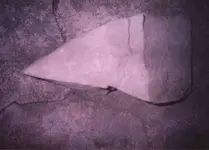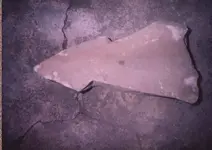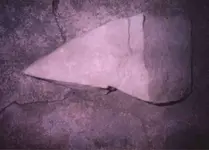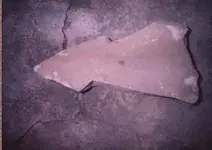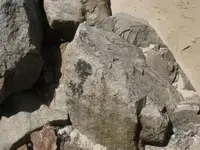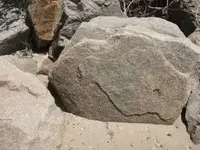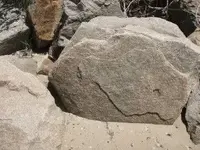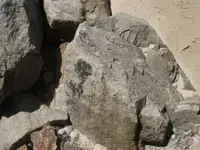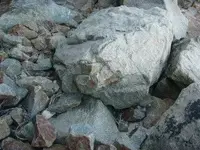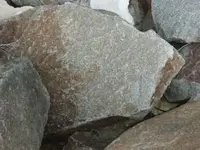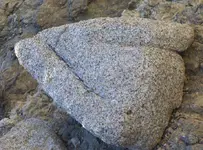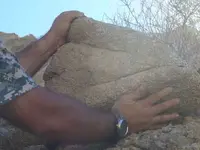You are using an out of date browser. It may not display this or other websites correctly.
You should upgrade or use an alternative browser.
You should upgrade or use an alternative browser.
POINTER ROCK?
- Thread starter kaloy
- Start date
D
dowser501
Guest
I call those small markers companion rocks. Very common, as they laid them around their turtleback markers. When you get back there, you should dig around the bases of the large markers, you might get a surprise.
D
dowser501
Guest
Kaloy, the Philippines and Australia have one thing in common, we were both home to the Jesuits for a couple of centuries. Pictures taken in Port Phillip Bay Victoria Australia Notice one side of the arrow is longer. Arrow was lying parallel to the cliff and the longer end of the arrow was on the cliff. Yours also has a longer side on a point which is pointing somewhere. I know where mine is pointing. It is hallowed ground historically. The turtleback is looking sideways at the same hidden cache entrance. The lower second turtleback was found trundling along the beach and nearby was a second arrow marker pointing at a cliff entry point for a cache. The longer side of the arrow is the actual pointer, not the point of the arrow. You sidle sideways. Kaloys pic is a very good specimen as long as the rock hasnt been moved.
I once many years ago pointed our a cliff front site for entry to a cache on the beach front cliff face on the california coast line. Dowsing reception was brilliant at that time and I was able to guide the two diggers to the exact spot on the cliff face and dig inwards.
I informed them of how far they would have to dig inwards and as I was mentally picking up a stalactite presumably cemented to the left hand
wall pointing right. Dowsing to the right I was looking down at a large unknown quantity of gold bars. Using my attourney we made up an electronic contract. Weeks went by and they went quiet. I dowsed again when I again had power and the gold was missing. There was no way that I could contact them. It was as though they had vanished off the face of the Earth. I had not told them that the Jesuits always inserted at the same distance again inland another cache and it was safe.
A year later I checked the second cache and it was gone. I reckon the two caches could have been several tons each.
Come January and say that I am dowsing again, kaloy how can I guarrantee that you are trustworthy. You can work that one out. I have had three smaller caches where the finders virtually swore on their mothers graves they were honest, and they all vanished.
I have a small cache of silver in a leather bag hidden on an Island near Salt Lake city. When I mean small it is nothing like a Jesuit cache however if someone wanted to find it I have the coordinates and you would need a motorised motorboat as it is about three quarters along the outer end of the Island.
Keep Safe max
I once many years ago pointed our a cliff front site for entry to a cache on the beach front cliff face on the california coast line. Dowsing reception was brilliant at that time and I was able to guide the two diggers to the exact spot on the cliff face and dig inwards.
I informed them of how far they would have to dig inwards and as I was mentally picking up a stalactite presumably cemented to the left hand
wall pointing right. Dowsing to the right I was looking down at a large unknown quantity of gold bars. Using my attourney we made up an electronic contract. Weeks went by and they went quiet. I dowsed again when I again had power and the gold was missing. There was no way that I could contact them. It was as though they had vanished off the face of the Earth. I had not told them that the Jesuits always inserted at the same distance again inland another cache and it was safe.
A year later I checked the second cache and it was gone. I reckon the two caches could have been several tons each.
Come January and say that I am dowsing again, kaloy how can I guarrantee that you are trustworthy. You can work that one out. I have had three smaller caches where the finders virtually swore on their mothers graves they were honest, and they all vanished.
I have a small cache of silver in a leather bag hidden on an Island near Salt Lake city. When I mean small it is nothing like a Jesuit cache however if someone wanted to find it I have the coordinates and you would need a motorised motorboat as it is about three quarters along the outer end of the Island.
Keep Safe max
Attachments
kaloy
Sr. Member
- #5
Thread Owner
Max,
Right now I am using all the knowledge and informations available to me. This is the reason that i brought this project out. I am studying this for two years now. This was my very first project. But I dont have intensive diggings yet in the site. All I have were clues. Others discouraged me to pursue this project for the reason that the markers were not accurate treasure markers. (all the markers pix were now posted under 'cylindrical cement markers').
Then you came. To some point my uncertainty was neutralized. You were mentiioning that the markings were jesuit rock petroglyph. Tho I am somewhat hesitant to accept that it was Jesuit's ( mine is Japs'), at least, the point is the same, that it was a treasure marker. And I thank you for making my guess stronger.
If I were you I would have ask the same thing. Of course it is completely logical to know the honesty,trustworhty, sincerity,etc, of a person before eentrusting him million 0r billion-worth information. It is logical to give not the info yet.
Right now I am using all the knowledge and informations available to me. This is the reason that i brought this project out. I am studying this for two years now. This was my very first project. But I dont have intensive diggings yet in the site. All I have were clues. Others discouraged me to pursue this project for the reason that the markers were not accurate treasure markers. (all the markers pix were now posted under 'cylindrical cement markers').
Then you came. To some point my uncertainty was neutralized. You were mentiioning that the markings were jesuit rock petroglyph. Tho I am somewhat hesitant to accept that it was Jesuit's ( mine is Japs'), at least, the point is the same, that it was a treasure marker. And I thank you for making my guess stronger.
If I were you I would have ask the same thing. Of course it is completely logical to know the honesty,trustworhty, sincerity,etc, of a person before eentrusting him million 0r billion-worth information. It is logical to give not the info yet.

gollum
Gold Member
- Joined
- Jan 2, 2006
- Messages
- 6,770
- Reaction score
- 7,734
- Golden Thread
- 0
- Location
- Arizona Vagrant
- Detector(s) used
- Minelab SD2200D (Modded)/ Whites GMT 24k / Fisher FX-3 / Fisher Gold Bug II / Fisher Gemini / Schiebel MIMID / Falcon MD-20
- Primary Interest:
- All Treasure Hunting
Hey Kaloy,
I think that what you have there is natural. It doesn't have that worked look I would expect to see in a small arrow pointer.
I don't know what the rest of the rocks there look like, but if they are heavily fractured granite and/or quartz, it's most likely natural. That's not to say that it couldn't have been used as part of something larger, though.
Below are a couple of pics of a man made small arrow pointer. It's in the Anza-Borrego Desert in Southern California. It leads one down a wash to a well mined arroyo with a ton of prospector holes (coyote holes).
Notice how the back is worked to be exactly like the front. The picture in which I'm holding it, shows the back side.
Best,
Mike
I think that what you have there is natural. It doesn't have that worked look I would expect to see in a small arrow pointer.
I don't know what the rest of the rocks there look like, but if they are heavily fractured granite and/or quartz, it's most likely natural. That's not to say that it couldn't have been used as part of something larger, though.
Below are a couple of pics of a man made small arrow pointer. It's in the Anza-Borrego Desert in Southern California. It leads one down a wash to a well mined arroyo with a ton of prospector holes (coyote holes).
Notice how the back is worked to be exactly like the front. The picture in which I'm holding it, shows the back side.
Best,
Mike
Attachments
A
adrian201230
Guest
kaloy,
that's a nice pointer rock you got there. how deep did you get it? what is the other sign before that?
adrian201230
that's a nice pointer rock you got there. how deep did you get it? what is the other sign before that?
adrian201230
D
dowser501
Guest
You would be wise if you ignored all pointers. The Jesuits were not that naive.It took me about 18 years to understand what the Jesuits arrows meant, and they certainly are not pointing the way to treasures. If you dont ignore them, interperate what they mean as the likelyhood that they point to treasure is as remote as father XMAS. I am not trying to be superior, but if I told you what a Jesuit arrow meant < would you believe me? however it has a heart on one end meaning gold here and also warns of a death trap'
kaloy
Sr. Member
- #9
Thread Owner
adrian201230 said:kaloy,
that's a nice pointer rock you got there. how deep did you get it? what is the other sign before that?
adrian201230
its in the surface. this is my problem, its size. a surface marker should be larger than this i guess.
i got this in a hillside. anchored by another rock. well-placed. it is pointing downward to an eroded portion of the hill.
I inspected this site two years ago bec my grandfa told me that he was forced during the japs occupation to worked in a tunnel somewhere in that site( he can no longer pinpoint the exact location).
I also got a stair-shaped rock. it has 3 stairsteps. if you go down to the direction of the stairs, you will arrived at the same place where the pointer is pointing.
kaloy
Sr. Member
- #10
Thread Owner
gollum said:Hey Kaloy,
I think that what you have there is natural. It doesn't have that worked look I would expect to see in a small arrow pointer.
I don't know what the rest of the rocks there look like, but if they are heavily fractured granite and/or quartz, it's most likely natural. That's not to say that it couldn't have been used as part of something larger, though.
Below are a couple of pics of a man made small arrow pointer. It's in the Anza-Borrego Desert in Southern California. It leads one down a wash to a well mined arroyo with a ton of prospector holes (coyote holes).
Notice how the back is worked to be exactly like the front. The picture in which I'm holding it, shows the back side.
Best,
Mike
yeah... nice arrow.
kaloy
Sr. Member
- #11
Thread Owner
dowser501 said:You would be wise if you ignored all pointers. The Jesuits were not that naive.It took me about 18 years to understand what the Jesuits arrows meant, and they certainly are not pointing the way to treasures. If you dont ignore them, interperate what they mean as the likelyhood that they point to treasure is as remote as father XMAS. I am not trying to be superior, but if I told you what a Jesuit arrow meant < would you believe me? however it has a heart on one end meaning gold here and also warns of a death trap'
max,
i will be glad to know the meaning of a Jesuit's arrow.
A
adrian201230
Guest
kaloy,
Not all the time japs use larger pointer rock, sometimes they use smaller ones, in order to find the right spot or the entrance to the tunnel is to look for another sign near the first one you saw, have you try clearing the place where the pointer rock has pointed? if not try to clear it, you might find the next sign.. The 3 steps you found means " death victim (no treasure)", look deeply for another sign...
Good day!!!!
Adrian
Not all the time japs use larger pointer rock, sometimes they use smaller ones, in order to find the right spot or the entrance to the tunnel is to look for another sign near the first one you saw, have you try clearing the place where the pointer rock has pointed? if not try to clear it, you might find the next sign.. The 3 steps you found means " death victim (no treasure)", look deeply for another sign...
Good day!!!!
Adrian
D
dowser501
Guest
Kaloy< The poiny of pointers don't mean a thing. The arrows were used parallel to the target and you are guided in sideways by the longest side of the arrow point. If you look carefully, none of the above pointers have identical length sides.
kaloy
Sr. Member
- #14
Thread Owner
dowser501 said:Kaloy< The poiny of pointers don't mean a thing. The arrows were used parallel to the target and you are guided in sideways by the longest side of the arrow point. If you look carefully, none of the above pointers have identical length sides.
based on the location of the arrow, you are absolutely correct!
D
dowser501
Guest
When the dowsing season starts next January( hopefully) I can transpose the target onto my front lawn and examine it from all sides and if given enough markers can walk you straight to it.
kaloy
Sr. Member
- #16
Thread Owner
dowser501 said:When the dowsing season starts next January( hopefully) I can transpose the target onto my front lawn and examine it from all sides and if given enough markers can walk you straight to it.
Max,
I dont have enough knowledge when it comes to dowsing and I cant figure it out how will you do it. Maybe you're clairvoyant, arent you?
Anyway, I posted the pic of the southern portion of the site.(cylindrical cement marker). If you havent seen the new markers i posted pls check it out.
D
dowser501
Guest
kaloy I have seen the markers in your other post and they point to the treasure without a doubt. Arrows are a feinting move, whilst the real pointer is staring you in the face. The jesuit didnt rely on you having the IQ of a brain surgeon to find their treasures.
To find the clue, I had to study hundreds of different markers at many different sites even in different parts of the Pacific and there was always one particular marker that was always there.
It reminds me of the quickstep in modern dancing. If I was clairvoyant , it would still not be possible to have found the common clue to all the treasures I have looked at without a lot of hard work.
There is another posting by Tommi from Queensland which I have been going over and over, knowing I was missing something.Staring at his photos the other day it hit me like a rock what I had missed maybe several dozens of times prior. Like your petroglyphs, the clues are too simple to understand readily. Even that cute arrow shaped companion Jesuit rock further up in post no.has the clue to
the treasure on it.the treasure
To find the clue, I had to study hundreds of different markers at many different sites even in different parts of the Pacific and there was always one particular marker that was always there.
It reminds me of the quickstep in modern dancing. If I was clairvoyant , it would still not be possible to have found the common clue to all the treasures I have looked at without a lot of hard work.
There is another posting by Tommi from Queensland which I have been going over and over, knowing I was missing something.Staring at his photos the other day it hit me like a rock what I had missed maybe several dozens of times prior. Like your petroglyphs, the clues are too simple to understand readily. Even that cute arrow shaped companion Jesuit rock further up in post no.has the clue to
the treasure on it.the treasure
kaloy
Sr. Member
- #18
Thread Owner
dowser501 said:kaloy I have seen the markers in your other post and they point to the treasure without a doubt. Arrows are a feinting move, whilst the real pointer is staring you in the face. The jesuit didnt rely on you having the IQ of a brain surgeon to find their treasures.
To find the clue, I had to study hundreds of different markers at many different sites even in different parts of the Pacific and there was always one particular marker that was always there.
It reminds me of the quickstep in modern dancing. If I was clairvoyant , it would still not be possible to have found the common clue to all the treasures I have looked at without a lot of hard work.
There is another posting by Tommi from Queensland which I have been going over and over, knowing I was missing something.Staring at his photos the other day it hit me like a rock what I had missed maybe several dozens of times prior. Like your petroglyphs, the clues are too simple to understand readily. Even that cute arrow shaped companion Jesuit rock further up in post no.has the clue to
the treasure on it.the treasure
Max,
I am planning to open the hillside soon. With or without i'll let you know partner.
D
dowser501
Guest
Kaloy, if you start digging without getting advice from your junior 30% partner you will be wasting your time. If you already know the following queries fine.
Where exactly do you intend digging without having a target pin pointed for you first?
How deep will you dig?
Are you going to use a back hoe or by hand.
What shape is the buried treasure? As the Jesuits never buried treasure without an accompaning death trap?
and in what form would the trap come?
Approximately how much treasure is in these type of caches?
And lastly but most important of all. what underground markers will to expect to see to guide you down to the cache.
Where exactly do you intend digging without having a target pin pointed for you first?
How deep will you dig?
Are you going to use a back hoe or by hand.
What shape is the buried treasure? As the Jesuits never buried treasure without an accompaning death trap?
and in what form would the trap come?
Approximately how much treasure is in these type of caches?
And lastly but most important of all. what underground markers will to expect to see to guide you down to the cache.
kaloy
Sr. Member
- #20
Thread Owner
dowser501 said:Kaloy, if you start digging without getting advice from your junior 30% partner you will be wasting your time. If you already know the following queries fine.
Where exactly do you intend digging without having a target pin pointed for you first?
How deep will you dig?
Are you going to use a back hoe or by hand.
What shape is the buried treasure? As the Jesuits never buried treasure without an accompaning death trap?
and in what form would the trap come?
Approximately how much treasure is in these type of caches?
And lastly but most important of all. what underground markers will to expect to see to guide you down to the cache.
Max,
My idea is simple. I'll try to clear the hillside to expose the opening. Once the opening is exposed, the rest is chicken.
If i fail, i'll run to you and ask you "max where really is it?" and if i succeed, i'll meet you in melbourne. i'll hand you personally your share.
The site is not accesible to heavy equipments like backhoe.
Why not try me with the smaller treasure(giveaway)? So I can fly to melbourne right away.

Similar threads
- Replies
- 0
- Views
- 107
Users who are viewing this thread
Total: 1 (members: 0, guests: 1)



